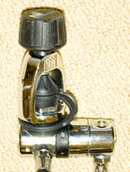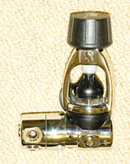beachnik
Contributor
I've just picked up two nice used MK10s which you can see here. Click on the photos to enlarge. These are my first piston regs. The one with the black rubber seal around the ambient chamber is an MK10 rebuilt with the 'plus' components.
The other reg is a standard MK10, looking like it was just driven off the showroom floor — it's a beauty!
Neither have any silicone grease in the ambient chambers.
I dive warm, tropical water. I'm pretty fastidious with my stuff - they'll get soaked in fresh water at the end of the dive day.
I presume the standard protocol for my type of diving is to 'not' put silicon grease in the ambient chamber - yes? no? (My service guy automatically left it out of the MK10+).
In the case of using silicone grease in the ambient chamber, I think that rubber ring with holes is designed to keep some of the grease from oozing out (?). If you use grease, are you supposed to twist the rubber ring so it's holes don't line up with the holes in the ambient chamber? (I would think that pressure would still be able to get through to the interior of the ambient chamber).


The other reg is a standard MK10, looking like it was just driven off the showroom floor — it's a beauty!
Neither have any silicone grease in the ambient chambers.
I dive warm, tropical water. I'm pretty fastidious with my stuff - they'll get soaked in fresh water at the end of the dive day.
I presume the standard protocol for my type of diving is to 'not' put silicon grease in the ambient chamber - yes? no? (My service guy automatically left it out of the MK10+).
In the case of using silicone grease in the ambient chamber, I think that rubber ring with holes is designed to keep some of the grease from oozing out (?). If you use grease, are you supposed to twist the rubber ring so it's holes don't line up with the holes in the ambient chamber? (I would think that pressure would still be able to get through to the interior of the ambient chamber).






